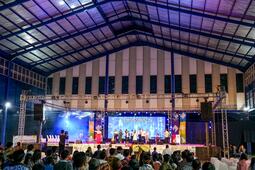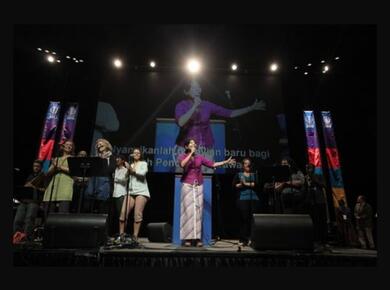Posted: November 16, 2021
“For truly I tell you, if you have faith the size of a mustard seed, you will say to this mountain, ‘Move from here to there,’ and it will move; and nothing will be impossible for you.” (Matthew 17:20)
In July 2009, leaders from the three Indonesian Mennonite conferences GITJ, GKMI and JKI found themselves in a conversation outside a dormitory in Asuncíon, Paraguay. Although they were not strangers, their paths rarely crossed. Singing together at one of the Assembly’s worship services in Paraguay was their first time completing a task together.
The three groups they represented had complex histories that included separation and division, but that day when they sang together in Paraguay, they aptly chose the popular Indonesian song “In Jesus We Are Brothers and Sisters”.
There, in the relaxed context of the 15th Assembly of Mennonite World Conference, something significant shifted in their relationship. “We realized that all of us were of a similar age and that we shared many of the same concerns and values,” says David Meijanto.
For the first time, members of the group asked: Why don’t we get together more often back in Indonesia?
The church leaders returned to Indonesia with a commitment to meet every three months to share together and encourage each other. At one of those “Indo-Menno” meetings, the idea emerged that the three groups could together host the 2021 MWC global assembly in Indonesia. Their proposal to host the Assembly in 2021 was accepted by MWC’s General Council during 2012 meetings in Basel, Switzerland.
Today, leaders of these three synods are looking beyond their differences to seek new partnerships with each other and with the larger Mennonite world.
Moving mountains
When the pandemic hit the world in early 2020, non-essential travels came to a halt. Although MWC Assemblies in Zimbabwe coincided with epidemics before (Zika in 2015; H1N1 in 2009; SARS before 2003), no one at MWC had experienced a global outbreak that necessitated cancellation of all travel.
Quickly the national advisory committee agreed to postpone the Assembly to 2022, also shifting the format to hybrid: offering in-person and virtual participation.
Now, as the country prepares to loosen travel restrictions and allow tourists from 18 countries to come, the three synods that make up the Mennonite church in Indonesia are looking forward to welcoming you in July 2022 – in person or virtually.
Regardless of how you choose to participate, Indonesia 2022 will offer a great perspective on the ways Anabaptism has taken root in Indonesia.
It is not too soon to put July 5-10, 2021, in your calendar. Registration opens in December 2021.
About the three Mennonite synods in Indonesia:
Gereja Injili di Tanah Jawa (evangelical church of Java – GITJ)

GITJ emerged in 1854 from the work of Dutch Mennonite missionary and linguist Pieter Jansz. It was the first Anabaptist-Mennonite congregation in the world whose members were not primarily of European or North American origin. An influential figure in the early history of the GITJ was Kyai Ibrahim Tunggul Wulung, a local mystic who helped enculturate the gospel message into a distinctively Javanese idiom. As of 2019, members of the 117 GITJ congregations tend to live in rural areas around Jepara and Pati, speak Javanese, work as labourers and worship in a somewhat formal liturgical style.
Gereja Kristen Muria Indonesia (Muria Christian church of Indonesia – GKMI)

GKMI traces its roots to Chinese immigrants who settled in Java in the early 20th century. In 1917, Tee Siem Tat, a Chinese businessman, became a Christian when he and another family member were miraculously healed after listening to Gospel stories. The resulting congregations’ Anabaptist identity was strengthened in the 1950s and 1960s, when Hermann Tann consciously worked to introduce Mennonite theology and polity. In 2020, some 129 congregations make up the GKMI. Its members tend to be of Chinese background, well-educated and strongly committed to missions.
Jemaat Kristen Indonesia (Christian congregations of Indonesia – JKI)

JKI emerged in the late 1970s as a charismatic renewal movement within the GKMI. Led by Adi Sutanto, a small GKMI prayer group began to incorporate speaking in tongues, faith healing, visions and prophecy into their regular worship. JKI, formed in 1985, has since grown to include 400 congregations today, including several in the United States, Australia and the Netherlands. The best-known JKI church combines charismatic worship with social ministries and a strong outreach program in the city of Semarang. This 20,000-member “Holy Stadium” is the site of the MWC Assembly in 2021.
—Original article written by John D. Roth, MWC Faith and Life Commission, secretary; professor of history at Goshen College, Indiana, USA; director of the Institute for the Study of Global Anabaptism. Updated in October 2021 by Mennonite World Conference.







Comments: